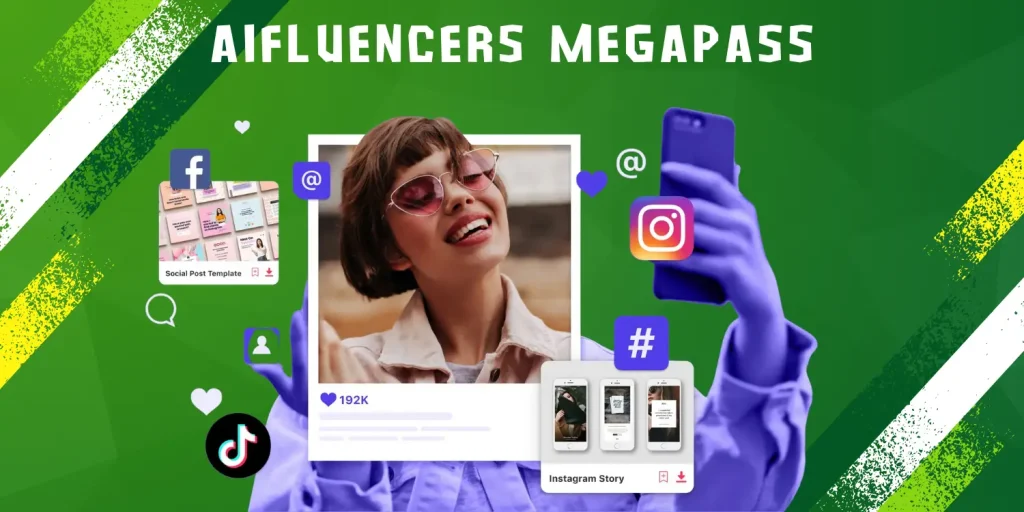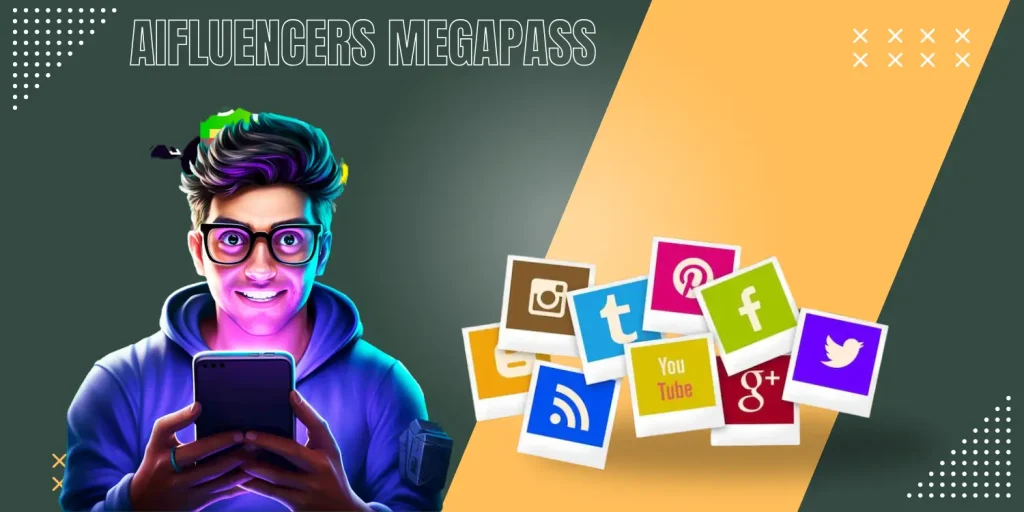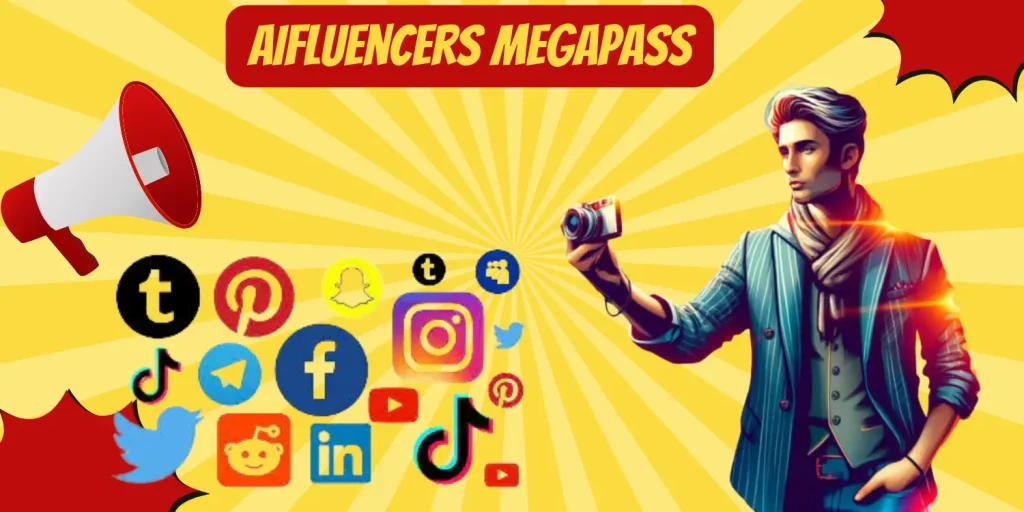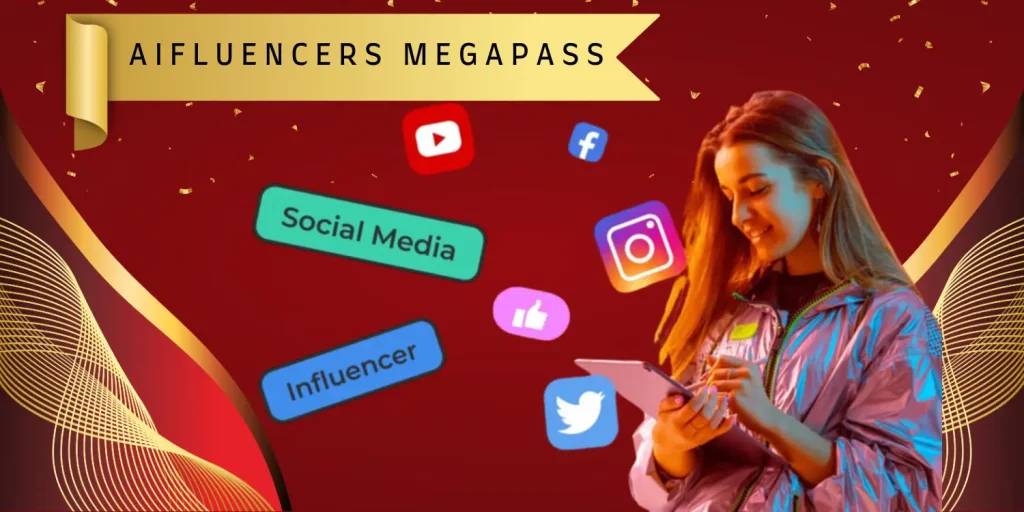Introduction to AI Influencer Megapass
What concerns business and art, as well as fans, is the process of interaction with AI in the digital space is now undergoing a complete transition due to the Megapass AI Influencer. It is simply a great tool that provides people with a number of options of AI solutions that are hardly comparable to anything in the context of the connected world, and as art and computers become one, it overpowers and attracts a lot. AI Influencer Megapass is a useful tool to have for getting to the ultimate goal, whether that is creating content or simply using social media to achieve multiple goals in a productive and efficient manner.
The AI Influencer Megapass is a fully customisable, turnkey AI solution that includes a balancing toolset that is based on the latest AI approach. These are a few options and services that include custom content creation, audience measurement, auto-posting, and influencer marketing services. To help our customers more easily manage AI Influencer Megapass accounts, the tools also provide features where customers can create more magnificent and relevant pictures for the target customers and generate more original sound and their brand voice that makes them touched easier and faster and save more money.
This platform is going to prove useful in a number of contexts within the unpredictable sphere of the digital market to either help market more effectively or gain more subscribers as an up-and-coming influencer.
But as the layout shows, the simplicity is the main advantage of the AI Influencer Megapass here. As with real income sources being updated in real time, the platform can be used to learn more about trends ongoing within society while also providing users with ways to keep releasing really useful insights that help guide decision-making. Whereas the creation of design for technical experts and art lovers, the interface developed is very simple; it can be used by anyone.
On top of it is the AI Influencer Megapass that guides the stream of influence to have far more real, engaging, and meaningful online interactions. It is a helpful resource for anyone who wants to have good performance in the world influenced by artificial intelligence since it focuses on productivity as well as outcome optimisation.

What Are AI Influencers Used For?
AI influencer is a more common name used for traditionally virtual characters in the current world as businesses more and more incorporate them for various purposes. These digital characters, who very often mimic human characteristics and behaviors, perform in front of audiences on social media platforms, which is similar to traditional influencers. The following are some important uses for AI influencers:
1. Promotion and advertising.
Brands employ AI influencers to market such products and services. They can be developed specifically to provide an ideal fit to a brand and consistently reflect its image, tone of departure, and overall value proposition, which cannot be said of real influencers. Concerning influencer campaigns, examples are Shudu Gramme and Lil Miquela, who help achieve advertisement awareness and bring on new, youthful audiences familiar with technology.
2. Economic Effectiveness
AI influencers, on the other hand, eliminate costs such as travel expenses, product costs, or time limits that are associated with human influencers. Employers may write large volumes of personalized content in advance and ensure that their virtual ambassador is always reliable, coherent, and lethally accurate.
3. Adaptive AI is another type of customisable content, as AI influencers can change the content and the way they present themselves to their audience. With the help of data analytics, they enhance the brand’s target consumers’ engagement by offering content that fits their chosen audience.
4. Education and creativity
Marketing, games, virtual reality, and other such activities utilise AI influencers in terms of a narrative. These stories include small, recurring characters that instantly appeal to viewers and present them with a narrative.
5. Data collection and testing
AI influencers help brands determine their audience’s reception to a campaign before recruiting human influencers or launching comprehensive projects. It also makes it possible to enhance the strategies and focus on the right audience in the right way.
6. Awareness and education
AI influencers can provide audiences with information, advocate for a cause, and raise awareness in environmental or social matters. They are successful in lobbying campaigns due to their continual ability to disseminate knowledge.
Specifically, AI influencers present new strategies to address audiences and revolutionize the influencer industry by combining innovative solutions, immediacy, and upscale values.

How does it work with influencers?
Influencers are today’s essential parts of those marketing strategies. They change the perception towards and buying behaviour of their followers by utilising social media as a platform to market companies, products, and services. The place of the influencer, forms of influencers, ways of partnering, and campaign effectiveness are all critical points for understanding the operation of influencer marketing.
The role of influencers
Micro-celebrities are individuals who, via sharing content related to fashion, beauty tips, fitness, new technologies, travelling, etc., have a page or an account on Instagram, YouTube, TikTok, or Twitter. More often than not, they engage their audience with simple authenticity, thereby creating rapport, which leads to active interaction. This is why when brands, especially the ones targeting specific demographics, can be helped by their endorsement.
Influencer Types
Influencers fall into a variety of sizes and niches, including:
Mega influencers are celebrities with millions of followers who have the greatest impact on their audiences. Although they are well-known, they give their service at very high prices most of the time.
Macro influencers are social media influencers that have between hundreds of thousands to a few million followers. They are cheaper, yet their benefits seem to be higher.
• Micro-influencers: Those with quite modest but highly engaged audiences, sometimes from one thousand to one hundred thousand. In many cases, specific concentration leads to high levels of trust and better ROI for the brands.
• Nano-influencers: A unique audience type that is composed of individuals who have very few subscribers—usually under a thousand—with whom they have a strong affinity.
Models of Collaboration
Depending on the objective of the campaign, influencers and companies can work together in a number of ways:
1. Sponsored Posts: For that, the influencer provides material that promotes a brand’s products or services in exchange for financial consideration.
2. Affiliate Marketing: Affiliates provide unique codes or links to clients for a cut derived from every lead or sale that results from the tip provided.
3. Product Reviews: Ordinary people have the products provided by the brands and give the comments or outlooks in their blogs or videos, or just on the social networks.
4. Prizes and contests: Both influencers and brands organize a sweepstake or giveaway that increases recognition of the brand or product and encourages others to participate.
It is evident that influencer marketing can be effective.
This makes influencer marketing a highly efficient strategy because it targets very specific audiences. There are feelings that influencers’ messages are much closer to authentic advertisements, as influencers are already trusted in their communities. Social media networks also contain measurable parameters: click-through rates and engagement rates, which allow marketers to track the efficiency of actions in influencers’ accounts in real time.
In other words, influencer marketing relies on the ability of individuals who establish an audience and followers. Since it targets a specific audience and helps brands to create better connections with potential consumers, it is an essential tool in the present-day marketing context using a variety of collaboration models.

Who is the most famous influencer?
There are reasons why the title of the most famous influencer is constantly shifting: social media platforms are developing, and new trends in digital content appear. At the same time, with some people, certain positions have strengthened and become authoritative on their own. Sportsmen can also use social media, and Cristiano Ronaldo is an example of one of the most popular and effective influencers in different social networks.
The images that probably garner the most likes and followers, at least in terms of sports personalities, belong to Cristiano Ronaldo, the famous Portuguese professional football player. In the beginning of early 2025, he has more than 550 million fans on Facebook, Instagram, and Twitter. And that is why he has the biggest following; he is really the man with an immense following. While people view Ronaldo as the former football star with the FIFA award, there is more to him than just the soccer field.
This is true because, apart from sports, he has branded himself as a sportsman, a businessperson, and a humanitarian. He has the privilege to deal with high-profile companies such as TAG Heuer, Nike, and Clear to retail their products to the public. The mentioned collaborations prove not only his business influence but also his connection with numerous people. His posts, which reach millions of his fans across the world, often include sponsored content, family life, fitness regimes, and advertising campaigns.
Ralf’s beautifully crafted and maintained social accounts enhance his fame besides the victories scored. His utmost branding is felt on his Instagram profile in particular, I noticed. He shares behind-the-scenes glimpses of his training, his family, and the luxurious life he lived. That is why people and brands attracted to the combination of sincerity, desire, and glossiness are fans. He has built an essential role in the virtual platform because of his ability to relate with his audience while also showcasing his incredible life.
Absolute leaders in terms of numbers can be considered Ronaldo, but other famous influencers are Kylie Jenner, Dwayne “The Rock” Johnson, and Selena Gomez. Apart from being an influencer, Kylie Jenner is a rather successful businesswoman who built her success based on her significant following on Instagram. Likewise, Dwayne Johnson is one of the most versatile personalities on social media because of his overall personality and his multiple activities, such as acting, businesses, and charitable organizations.
Kylie Jenner is an important figure, particularly for fashion and beauty industries, due to her business investments and the large number of followers she has on her Instagram: 400 million plus. Maybe such influencers dreaming of making money from their followers might learn a thing or two from her, how she was able to turn her social media fans into customers with Kylie Cosmetics.
Apart from posting beautiful pictures and videos, Selena Gomez mainly uses her account to raise awareness of mental health issues, grow her acting career, and market her music. Different from the other influencers who only aim at making sales for the products, she has often used her popularity in a right way to raise awareness for some important social issues.
Due to the sheer numbers alone, Cristiano Ronaldo can be considered one of the most active and easily recognizable influencers on the web; however, there isn’t such a thing as the definitively most famous influencer because influence is contextual and ad hoc.

How to get an AI influencer online?
AI influencers, also referred to as “AIfluencers, are becoming an active part of influencer marketing in the contemporary new world. Consequently, these AI-created clones have their own attitudes, styles, ideas about fashion, and followers across various social platforms. Out of this pretext, businesses, organisations, and individuals are now looking forward to engaging AI influencers to enhance existing marketing strategies. But how can one attain an AIfluencer online?
1. It is important you understand what AIfluencers means.
Before going into the process of identifying, it is necessary to understand what AIfluencers entails. Similar to actual influencers, the created AI characters interact with the audience and create content. Often they appear in the form of avatars or virtual celebrities. Virtual humans, animal robots, mechanical, or any newly created figures using AI technology can all be referred to as AIfluencers. For brand name recognition, to sell a product, or just for fun, they are produced and have a certain appearance that is often designed by a computer program.
- Consult current AI popularizers.
It starts with research; one has to take their time and learn the new norm if they wish to become an AIfluencer. There are already many AI influencer accounts spreading on different social networking platforms, particularly on YouTube, Instagram, and TikTok. There are a few AI influencers who have gained considerable followership, the likes of Lil Miquela, Shudu, and Imma. Because of today’s advanced deepfake technology and impressive machine learning capabilities, these AI characters can interact with and possibly collaborate with human influencers. Through research of these organisations, it will be possible to find out which AIfluencers are suitable for a particular type of project and which are popular among different audiences.
3. Use artificial intelligence to reach influencers and influencer marketing companies.
There are many platforms and agencies whose goal is to link brands and individuals to AIfluencers. These agencies handle all the aspects inclusive of marketing campaigns, partnerships, as well as development and administration of AIfluencer. Brands like Brud and The Diigitals are companies that deal with showcasing personalities and virtual influencers produced by artificial intelligence technology. Depending on the desired result of cooperation—attracting a specific target audience, making a product advert, or just growing brand recognition—these platforms can find the most suitable AIfluencer for you depending on your preferences and goals.
4. Chasing the Tag: Building an AIfluencer of Your Own
You may build your own AIfluencer if you have a clear plan but fail to find one that fits your niche. This is a more elaborate and expensive method of creating an AIfluencer since you are able to tailor everything from the personality of the AIfluencer to the looks and its style of choice. The best way to make your future digital influencer come to life is to work with animators, graphic designers, and AI engineers. Moreover, there is software that allows for the creation of visually realistic avatars, even if you have no coding skills: Reallusion and Artbreeder.
5. Use Social Media
An AIfluencer’s following can be built on social media. To join a community, one applies its means, which include Instagram, Twitter, and TikTok. Being able to access an AIfluencer is slightly different, as you will need to stay active in the followers’ feeds and provide content. Sharing compelling photos, videos, and stories that reflect the AIfluencer’s brand and attributes is a positive beginning. Real influencer marketing can also enhance reach and credibility to invest in as well.
6. Social Media Tutorial: Legal and Ethical Considerations
There are a few legal and ethical considerations that need to be taken into consideration when interacting with AIfluencers. You must ensure that your AIfluencer’s behavior and content match your business’s values and that you grant the right rights and permissions for any content used. Another useful requirement is that the system should be transparent. ESoS should inform audiences that the influencer is artificial intelligence (AI)-generated in a bid to uphold their confidence.
7. This means to check on the extent of participation and organisation performance.
Last but not least, it is important to track the effectiveness of your AIfluencer. To ensure that the outcomes of your partnership are on the positive side, you should track metrics such as the conversion rates, reach, and engagement rates. Many platforms containing AI have analytics that enable you to evaluate the effectiveness of an AIfluencer and make changes to the strategy if needed.

What are the features of AIfluencers?
In fact, the new term AI fluencers, AIfluencers which is a blend of the terms AI and influencers, refers to virtual or AI-generated performers who employ AI to engage an audience, market products, or promote a form of belief on the internet. As opposed to real but influential users of social networks, AIfluencers are completely virtual beings originally designed and developed solely on the basis of AI technologies, including computer vision, machine learning, and natural language processing. As a unique and talented concept, AIfluencers are gradually entering many industries and becoming aware of countless industries such as marketing, entertainment, and fashion industries.
1. Lifelike Digital Avatars: In some cases, AI and CGI technology make AIfluencers look like reasonably realistic holograms; however, they switch with actual people. Since these avatars may replicate actual people in appearance and action, they contain the ability to both influence and generate passion in the audience. The advancements in artificial intelligence technology have allowed these sociable robots to imitate human moves of the eyes, as well as speaking, so that in fact it is hard to think of this interaction as close to being lifelike.
2. Data-Driven Content Creation: AIfluencers also hold the ability to create content from data. As our AIfluencers look at a vast amount of social media content, the favourite topics and trending topics, we may get content that is appropriate for the following. Since they follow a data-driven approach of interacting with their audience, they do better than other human influencers who have no time to be abreast of emerging trends.
3. Constant Availability: Unlike real-life influencers, there is no control over when AIfluencers need to sleep or even that they could become bored. With these, people can engage, post comments, post new content, and find TFTD, as well as interact with their followers at any given time. Since they can always be hired, flying billboards have become the popular publicity items among companies that require timely advertising.
4. Personalisation: The next AI influencers are rather famous for their personalised behavior. In particular, they are able to use specified types of machine learning to review the behaviour of users as well as to change the information, taking into account some preferences. An AI influencer may, for example, recommend products or services that the follower has engaged with, liked, or seen before in order to be helpful and successful in the marketing endeavor.
5. Openness and Ethical Issues: Of all the ethical concerns that AI influencers have raised, the two most important are transparency and authenticity. Since AI influencers are at liberty to share their opinion, then they may be inclined to endorse a product or business while at the same time concealing this with latent intents, unlike real influencers. It could be this is why there are some people who have an issue with the ethics of using avatars for the purpose of advertising a product or expressing an opinion.
That is, AI, which is a symbiosis of digital culture and technology, is beneficial to audiences, producers, and businesses in the form of AIfluencers. AIfluencers are going to take up a larger slice of influencer marketing and the production of online content as AI technology advances.

What can be done with AI influencers?
Virtual influencers, or AI influencers, are real, though they are powered by artificial intelligence, and they dominate social media and digital marketing. Like human influencers, who are artificially created human figures, those are virtual, having no human biological components in them; they are applications that use machine learning, natural language processing, and similar other technologies. AIfluencers have incredible impacts that will transform many industries and the way stakeholders and consumers engage themselves online in the future.
There are two primary application areas in marketing and brand partnership in the case of AI influencers. These animations can be programmed to interact in a certain way to suit the targeted audiences, the themes of the product, and brand values. This means that AI marketers make it easier for the brands involved to work on projects together without having to factor in human behavior, which is always unpredictable. AIfluencers have a lot of veto power on how a company is represented within an advert, post, or influencer marketing. Further, in social networks and blogs, they can be used to produce targeted content for individual clients and offer them more interesting experiences.
The other field where AIfluencers can be applied is in the entertainment industry. Through machine learning algorithms, one can produce virtual superstars with personality traits, history, and interests and wow audiences across media platforms. They can enhance the audience interest and communication narrative by appearing in internet series, music clips, video games, and virtual reality. For human influencers, it would be very difficult to emulate the proficiency of the AIfluencers in performing live-streamed events and communicating with followers in real time while creating striking experiences.
As such, AIfluencers can be employed to build engaging learning spaces within educational contexts. With virtual teaching using artificial intelligence, lessons may be presented, and enquiries may be directly answered, as well as provide immediate feedback, thereby raising questions of convenience and individualisation. In addition, AIfluencers suggest using mental health services among internet users to encourage them and offer support as well as practicing mindfulness.
Ultimately, AIfluencers offer a revolutionary opportunity to shape marketing, entertainment, and communication in a new, large-scale manner.

AIfluencers Conclusion?
AIfluencers simulate the complete metamorphosis in the digital ecosystem of the world as they demonstrate the benefits and drawbacks of integrating AI marketing and social media. Thanks to machine learning, deep learning, and natural language processing, these virtual beings are blurring the line between human and digital interactions and offering companies a new form of audience access.
Therefore, one of the big advantages of AIfluencers is that they can be present, persistent, and cost-effective all at the same time. It is different from human influencers because it can operate for 24 hours, thereby creating content, interacting with the followers, engaging in campaigns, among other things. For this reason, brands seeking predictable and reliable interactions without the booms and busts that human influencers may offer will find them attractive. Additionally, AIfluencers are entirely manageable by designers and can be adapted to certain brand images to represent a constructed personality that will resonate with certain audiences.
However, I agree with the author about the social and ethical issues that come with the new concept of AIfluencers. By the existence of the ability to create fake profiles, credibility, honesty, and clarity are thrown into the ditch. The key to influencer marketing is trust, and if the followers are not aware they are dealing with an AI, then the relationship built can be compromised. Lastly, since most of the AIfluencers present unrealistic photoshopped versions of reality, they can be blamed for contributing towards unrealistic beauty standards.
Finally, it can be stated that although AIfluencers can have unique opportunities for developing new approaches to the DM process, they can succeed in it only on condition that they solve the problem of a proper balance between ethical and innovative practices. Companies have to progress through this space ethically and with extreme care as to ensure that the role of artificial intelligence does not further erode genuine interpersonal relationships in the world of today’s Internet and social media. And so, it remains to be seen whether AIfluencers will remain relevant in the new digital environment, as well as how ethical the use of such influencer tools is.
